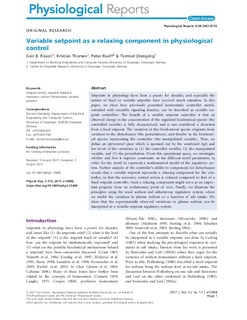| dc.contributor.author | Risvoll, Geir | |
| dc.contributor.author | Thorsen, Kristian | |
| dc.contributor.author | Ruoff, Peter | |
| dc.contributor.author | Drengstig, Tormod | |
| dc.date.accessioned | 2018-01-17T08:39:25Z | |
| dc.date.available | 2018-01-17T08:39:25Z | |
| dc.date.created | 2017-11-01T14:25:34Z | |
| dc.date.issued | 2017-09 | |
| dc.identifier.citation | Drengstig, T. (et al.) Variable setpoint as a relaxing component in physiological control. Physiological Reports, 5(e13408) | nb_NO |
| dc.identifier.issn | 2051-817X | |
| dc.identifier.uri | http://hdl.handle.net/11250/2477876 | |
| dc.description.abstract | Setpoints in physiology have been a puzzle for decades, and especially the notion of fixed or variable setpoints have received much attention. In this paper, we show how previously presented homeostatic controller motifs, extended with saturable signaling kinetics, can be described as variable setpoint controllers. The benefit of a variable setpoint controller is that an observed change in the concentration of the regulated biochemical species (the controlled variable) is fully characterized, and is not considered a deviation from a fixed setpoint. The variation in this biochemical species originate from variation in the disturbances (the perturbation), and thereby in the biochemical species representing the controller (the manipulated variable). Thus, we define an operational space which is spanned out by the combined high and low levels of the variations in (1) the controlled variable, (2) the manipulated variable, and (3) the perturbation. From this operational space, we investigate whether and how it imposes constraints on the different motif parameters, in order for the motif to represent a mathematical model of the regulatory system. Further analysis of the controller's ability to compensate for disturbances reveals that a variable setpoint represents a relaxing component for the controller, in that the necessary control action is reduced compared to that of a fixed setpoint controller. Such a relaxing component might serve as an important property from an evolutionary point of view. Finally, we illustrate the principles using the renal sodium and aldosterone regulatory system, where we model the variation in plasma sodium as a function of salt intake. We show that the experimentally observed variations in plasma sodium can be interpreted as a variable setpoint regulatory system. | nb_NO |
| dc.language.iso | eng | nb_NO |
| dc.publisher | Wiley Periodicals Inc. | nb_NO |
| dc.rights | Navngivelse 4.0 Internasjonal | * |
| dc.rights.uri | http://creativecommons.org/licenses/by/4.0/deed.no | * |
| dc.subject | integral control | nb_NO |
| dc.subject | negative feedback | nb_NO |
| dc.subject | variable setpoint | nb_NO |
| dc.subject | rheostasis | nb_NO |
| dc.subject | sodium homeostasis | nb_NO |
| dc.subject | fysiologi | nb_NO |
| dc.title | Variable setpoint as a relaxing component in physiological control | nb_NO |
| dc.type | Journal article | nb_NO |
| dc.type | Peer reviewed | nb_NO |
| dc.description.version | publishedVersion | nb_NO |
| dc.rights.holder | © 2017 The Authors | nb_NO |
| dc.subject.nsi | VDP::Matematikk og Naturvitenskap: 400::Basale biofag: 470 | nb_NO |
| dc.source.volume | 5 | nb_NO |
| dc.source.journal | Physiological Reports | nb_NO |
| dc.source.issue | 17 | nb_NO |
| dc.identifier.doi | 10.14814/phy2.13408 | |
| dc.identifier.cristin | 1509851 | |
| cristin.unitcode | 217,8,4,0 | |
| cristin.unitcode | 217,8,2,0 | |
| cristin.unitname | Institutt for data- og elektroteknikk | |
| cristin.unitname | Institutt for matematikk og naturvitenskap | |
| cristin.ispublished | true | |
| cristin.fulltext | original | |
| cristin.qualitycode | 1 | |

